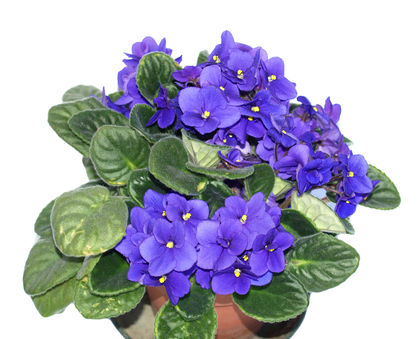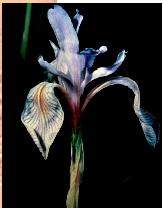Angiosperms

The angiosperms, or flowering plants, are the largest and most species-rich phylum of plants, with more than 250,000 species estimated.
Defining Characteristics
The term "angiosperm" derives from two Greek words: angeion, meaning "vessel," and sperma, meaning "seed." The angiosperms are those plants whose seeds develop within a surrounding layer of plant tissue, called the carpel, with seeds attached around the margins. This arrangement is easily seen by slicing into a tomato, for example. Collectively, carpels together with the style and stigma are termed the ovary, and these plus associated structures develop into the mature fruit. The enclosed seeds and the presence of carpels distinguish angiosperms from their closest living relatives, the gymnosperms , in which the seed is not enclosed within a fruit, but rather sits exposed to the environment. Some defining characteristics of angiosperms include flowers, carpels, and the presence of endosperm, a nutritive substance found in seeds, produced via a second fertilization event. However, some current studies suggest that endosperm is not unique to angiosperms.
Angiosperm flowers are generically characterized by having four whorls, or sets of organs: sepals , petals, stamens, and carpels. The carpels may be united or fused to form a compound pistil , and the number of stigma lobes may then be indicative of the number of carpels. The pistil also includes the stigma, on which pollen lands, and style, the tube leading to the egg. Stamens are separated into anthers, which produce pollen, and filaments. The mature ovary (part of the pistil containing the seeds) is termed a "fruit." Sepals and petals may be showy and colorful to attract pollinators, or may be quite reduced in wind-pollinated plants, such as grasses. Likewise, fruits may assume a wide variety of forms associated with mode of dispersal, such as fleshy fruits (for example, berries) dispersed by animals, and dry, winged fruits adapted for wind dispersal, such as the samaras of maple trees, which twirl like helicopters as they fall.

Evolution and the Angiosperms
The angiosperms are a relatively recent group of land plants, and are thought to have originated in the early Cretaceous, only 130 million years ago. The angiosperms increased dramatically in abundance during the Cretaceous. This sudden, dramatic appearance of large numbers of very diverse flowering plant species in the fossil record was referred to by English naturalist Charles Darwin as an "abominable mystery." It is postulated that coevolution with animal pollinators, especially insects, may have contributed to the explosion and abundance of angiosperm species which characterize the modern earth's flora. However, even today, it is not clear what group of nonflowering plants the angiosperms are most closely related to, or what the relationships of the early lineages of flowering plants are to one another. This is in part due to the extremely fast evolution of this group of plants, over a relatively short period of time, and the extinction of many closely related lineages of seed plants, some of which may be more closely related to the modern angiosperms than extant seed plant lineages.
Most contemporary studies, which are based on phylogenetic analysis of deoxyribonucleic acid (DNA) sequence data from as many as six different genes, suggest that the closest relatives of the angiosperms are the gymnosperms, which include cycads, Ginkgo, conifers (the group that contains the pines, spruces, firs, and relatives), and Gnetales (a group containing three ancient genera: Ephedra, the Mormon tea; Welwitschia, a bizarre plant of southwest African deserts; and Gnetum, a genus of mostly tropical vines). The origins of angiosperms are not well understood and remain problematic, in part because many seed plant lineages have already gone extinct. However, studies indicate that the earliest lineage of flowering plants, or basal angiosperms, may include the family Amborellaceae (with the single living species Amborella trichopoda, a shrub from the South Pacific island of New Caledonia). Other early diverging lineages of angiosperms include Nympheales, the water lilies; Illiciales, or star anise; a group called the magnoliids, which includes magnolias, laurels, and black pepper; and the very large group called the monocots . A final lineage, the eudicots , contains all other flowering plants and comprises the bulk (approximately three-quarters) of the flowering plant species.
Monocots, Dicots, and Eudicots
The angiosperms have historically been divided into two groups: the monocotyledons (monocots) and the dicotyledons (dicots). These terms derive from the number of seed leaves, or cotyledons , the plants have upon germination. Dicots have recently been shown not to be an evolutionarily natural group.
The monocots do form an evolutionarily natural, or monophyletic , group, and include familiar plants such as lilies, grasses, and palm trees. The monocots are characterized by having a single cotyledon, an adventitious root system, stems with scattered vascular bundles, absence of woody growth, leaves with parallel venation, flower parts usually in sets of threes, and monoaperturate pollen (that is, pollen with one large, groovelike aperture).
The dicots have historically included all those plants with two cotyledons, tap root systems, stems with vascular bundles in a ring, leaf venation forming a netlike pattern, and flower parts in fours or fives. Current studies indicate that the dicots do not form an evolutionarily monophyletic group, but instead include several different lineages, some of which are more closely related to the monocots.
Two groups that are well supported in contemporary studies are the eudicots ("true dicots"), characterized by having triaperturate pollen (that is, pollen with three long, groovelike apertures), and the noneudicots, which are characterized by having inaperturate pollen; that is, pollen lacking apertures. Noneudicot, basal angiosperms include the monocots, the laurels and avocados, the magnolias, black pepper, Amborella, water lilies and Illiciaceae (the star anise family). Evolutionary relationships among these noneudicot groups are not well understood. The eudicots include many familiar plants, including most trees, and include two major groups of flowering plants, the asterids (including the composite family, and the economically important Solanaceae, the potato family) and the rosids (including the rose family and the economically important legume family).
Diversity and Symbioses
Some of the most species-rich families of flowering plants include the monocot species of Orchidaceae, the orchids (19,500 species), the Poaceae or grass family (8,700), the Cyperaceae or sedge family (4,500), and the eudicot families of Euphorbiaceae or spurge family (6,900), the Fabaceae or legume family (18,000), the Rosaceae or rose family (3,000), Brassicaceae or mustard family (4,130), Rubiaceae or coffee family (9,000), the Lamiaceae or mint family (6,970), the Apiaceae or carrot family (4,250), and the Asteraceae or composite family (23,000).
The angiosperms are of great ecological importance and are principal components of nearly all of the major land habitats. Correspondingly, flowering plants are quite diverse in morphology , growth form, and habitat, and range from the minute aquatic plants in the duckweed family (genus Lemna ) to the massive forest trees, such as oak and maple. Angiosperm flowers can be quite reduced, as in the grasses, where the most visible floral parts are the stamens and stigmas, to quite elaborate floral structures exhibiting fusion of parts and development of complex shapes, such as those evolved to attract insect pollinators in the orchids, mints, and snapdragons.
An important aspect of angiosperm evolution is their well-documented relationships with other organisms such as animal pollinators, mycorrhizal (fungal) root associations, and even bacteria. Indeed, one of the most successful families of flowering plants, in terms of number of species, are the orchids, which have very specialized relationships with both pollinators and mycorrhizal interactions. Another highly successful family, the legume family, has evolved symbiotic relationships with nitrogen-fixing bacterial symbionts . Some flowering plants, such as the acacias of the legume family, obtain protection from herbivores via symbiotic relationships with ants. Through agriculture, humans have developed their own complex relationship with angiosperms. It is these relationships with other organisms that is the hallmark of angiosperms, and as such have contributed to the success of the flowering plants in the modern earth's flora.
SEE ALSO Conifers ; Fruits ; Gymnosperms ; Monocots ; Nitrogen Fixation ; Pollination and Fertilization ; Roots ; Symbiosis
Molly Nepokroeff and Elizabeth A. Zimmer
Bibliography
Crane, P. R., E. M. Friis, and K. R. Pederson. "The Origin and Early Diversification of Angiosperms." Nature 374 (1995): 27–33.
Judd, Walter S., Christopher S. Campbell, Elizabeth A. Kellogg, and Peter F. Stevens. Plant Systematics: A Phylogenetic Approach. Sunderland, MA: Sinauer Associates, Inc., 1999.
Kenrick, Paul. "The Family Tree Flowers." Nature 402 (1999): 358–359.
Parkinson, C. L., K. L. Adams, and J. D. Palmer. "Multigene Analyses Identify the Three Earliest Lineages of Flowering Plants." Current Biology 9 (1999): 1485–1488.
Comment about this article, ask questions, or add new information about this topic: